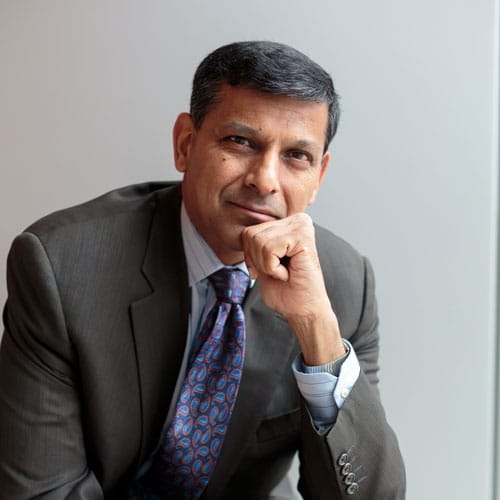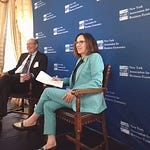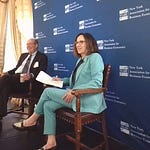An interview with Raghuram Rajan can cover so many important topics that it’s hard to decide where to begin and what all to cover.
For starters, he is a longtime professor of finance at the University of Chicago’s Booth School of business, a highly acclaimed economist known for his warning about the 2008 financial crisis years before it occurred. He was chief economist and director of research in the early 2000’s at the International Monetary Fund who went on to become governor of the Reserve Bank of India (RBI) and then vice chair of the BIS —the Bank for International Settlements, the organization whose memebers are central bankers from around the world.
With so many arguing at the IMF and World Bank Spring Meetings this week that tariffs are always and everywhere bad, for my interview with Dr. Rajan in Washington this past week I zeroed in on the U.S.-India trade negotiations where negotiators are still inching toward a deal. If they make it, Indian President Modi will be the first global leader to ink the kind of deal President Trump has been trying to land.
We cover a lot of trade territory here. He gives the potential U.S.-India trade agreement a thumbs up as a step that can bolster not just trade but all kinds of bilateral relationships, even as the actual gains or losses in trade may be small on both sides. He expains why in a nation where half its workers make their living as very small farmers, reaching an agreement on agriculture is especially hard.
In addition, he sketches out what a Federal Reserve step to cut rates could mean for future moves by the RBI. And much more.|
So dive in and hear what Raghu has to say. You will learn a lot in a short period of time and come away with a broader view of how these important tariff negotiations between two of the biggest economies in the world may work out.
India and the US face off an seem to find common ground 00:01:13:21
I do think that the U.S. has a case when it says our tariffs are low. Other countries tariffs are high. I think there's a a place where negotiations can take place. I'm glad they're taking place. I do think that every country has its own protected areas and sometimes having equal tariffs on the same goods doesn't necessarily work, doesn't necessarily even help add to trade, because, you know, some country in Africa is going to produce cocoa. What are you going to do? You're not going to produce cocoa in the U.S. And so bringing down tariffs on cocoa is is not particularly useful because you're not going to export. But there are places where I think you could get more trade. I think India, you know, after its liberalization in the early 1990, steadily brought down tariffs and it helped India.
Lower tariffs can improve competitiveness 00:02:22:22
It helped India because it made manufacturing more competitive and lower tariffs helped India sort of also get lower cost inputs for export. I think in the last few years, tariffs have been steadily moving up and I think that's problematic for India because it you know, it's very convenient for a businessperson to say, raise the tariffs, protect me. Yeah, I think that's an issue the US will have to confront as everybody travels to Washington to make a case for why they should be protected, but others shouldn't, and so on.
The India deal as a model?? 00:02:58:18
But really, I think the world is better off if tariffs are really lower all round. And to the extent that these talks between the US and India help do that for the bilateral relationship, it may also extend to other relationships. There are some sorts of sacred areas that India will be reluctant to reduce tariffs. Agriculture is one of those areas, and I think one can be perhaps a little more selective here. And say, okay, these are the places we can have more competition. We would welcome more competition. These are the places that we need more of a sliding scale. It can't all be done overnight. Over time, perhaps.
(Kathleen) Well, is that because many Indian farmers are poor and this is more there's is how they survive?
(Raghu) And these are not big farmers with 100,000 acre farms. These are farmers on half an acre. And so they really are struggling. And so from the Indian perspective, a shock here would be very, very difficult to bear. And so it has to be a more sort of steady process by which agriculture has opened up.
Not all tariff cuts will produce results- 00:06:33:12
Now, there are some places where I think, you know, there's a high tariff, for example, on car imports into India and India may well bring down that tariff given, uh, you know, the US focus on cars when they're making more cars and better cars in India, right. Well, they're making pretty good cars, but they mean cars which are also appropriate for the Indian road. Yeah. So, you know, I mean the US has specialized more and more on SUVs. You're not going to get a gigantic, you know, Chevy Suburban or something in India to have a large market. There may be some market, but it's not going to be a huge market. There's a place where India can easily say, okay, we're going to reduce that of significantly and let the Indian car producer compete.
India’s manufacturing advantage- 00:08:09:01
Where India's good is in the middle level manufacturing with a lot more engineering involved, but it's not mass production. And, you know, for example, India produces nuclear equipment for the US. It's not it's not really at the at the limit of technical sophistication, but it's reasonably sophisticated. Similarly, you know, there are Indian manufacturers who have, found world markets in two wheelers, motorcycles, scooters, things like that. So India has a place in manufacturing. It wants to do a lot more. But, of course, the world is becoming more and more hostile to manufacturing. And the argument we make is, look, the low skill manufacturing is going to be very difficult for at least three reasons. One is, of course, the growing protectionism. But even before that, what you have is a very, very competitive field where earlier you were competing with U.S. workers. Now you're competing with Vietnamese, Chinese and Bangladeshi workers. But the third problem, which is probably the most important at this point, is that it's getting increasingly automated. It's not creating as many jobs as you thought, which is actually going to be the problem for the U.S. administration. Those tariffs are not going to bring back the old jobs. They're gone, but not because of foreign competition.
India must go its own way 00:10:01:03
And the world doesn't have room for another China as it is. Right. Where India has been successful is on the services side. But services are so closely linked with manufacturing. So, for example, India doesn't manufacture any chips, but there are a lot of chip designers employed by Qualcomm, employed by Broadcom in India. And so what we need to do is recognize we need to be part of global supply chains.
How super-high US tariffs would impact the rest of the world 00:13:15:06
Okay… <if there are high tariffs in the US demand will> fall off, even if there's some attrition, it's not going to knock the economy into a recession. Unlike, for example, a country like Vietnam or Mexico, if tariffs were to come back high. What it does, however, is it creates a surplus of goods globally. So from the rest of the world, the real problem is demand is has weakened because the US is not purchasing as much from the rest of the world. And so a lot of goods are looking for a home elsewhere. So it's disinflationary rather than inflationary, which is the problem for the rest of the world. It's aggregate demand, which is a problem for the US, it's the opposite. Inflation is a problem and supply constraints are a problem. So if the Fed starts going to rate cutting path, what does it do for other central banks around the world? What does it mean for India? Is that another one where India says, hey, you know, our inflation is as low as the US, but we've got it in a band that is within our range? It doesn't mean much.
The policy dilemma 00:14:35:13
Well, I do think that Fed easing is typically a more reasonable environment for growth in the rest of the world than for Fed tightening. You're always worried when the Fed tightens that if you are behind the curve yourself, if unpleasant things happen, your currency weakens, capital flows out, etc.. On the other hand, when the Fed reduces rates, capital tends to look for a home in emerging markets and in other places.
A nice problem… but 00:15:09:19
It's a nice problem to have for a little while. Eventually it becomes a problem in its own right because you get overly your currency appreciates too much and you get overly hot. So, so I would say that to some extent, if the Fed does start sort of cutting rates in response to weakening US growth, that might be a relief for the rest of the world.
The dilemma part 00:15:38:20
The problem, of course, is this: does the Fed have that kind of room? Because for the U.S. it's a supply shock and the typical reaction to a supply shock is, you know, tighten demand. Not so much for the first round effect, but so it doesn't become a spiraling sort of bout of inflation. You have one round of inflation and then everybody sees prices are higher. You want to make sure that those second round effects don't start showing up and that's why I think it won't be that easy for the Fed, even unless growth sort of completely falls off a cliff. So there will be some important inflation. And the Fed was already uncomfortable with the level of inflation, given that it would plateaued since last year and wasn't going back to its target.
Raghuram Rajan
Raghuram Rajan is the Katherine Dusak Miller Distinguished Service Professor of Finance at the University of Chicago's Booth School. Prior to that, he was the 23rd Governor of the Reserve Bank of India from 2013 to 2016, as well as the Vice Chairman of the Board of the Bank for International Settlements from 2015 to 2016. Dr. Rajan was the Chief Economist and Director of Research at the International Monetary Fund from 2003 to 2006.
Dr. Rajan’s research interests range from banking and monetary policy to corporate finance, political economy, communities, and economic development. He co-authored Saving Capitalism from the Capitalists with Luigi Zingales in 2003. He then wrote Fault Lines: How Hidden Fractures Still Threaten the World Economy, for which he was awarded the Financial Times-Goldman Sachs prize for best business book in 2010. In 2019, his book, The Third Pillar: How Markets and the State Leave the Community Behind was a finalist for the Financial Times/McKinsey Business Book of the Year Award. His most recent book, with Rohit Lamba, is Breaking the Mold on reimagining India's economic future.
Dr. Rajan was awarded the inaugural Fischer Black award for the best financial economist under the age of 40 in 2003, the Deutsche Bank prize for financial economics in 2013, the Euromoney Central Bank Governor of the Year in 2014, and Banker magazine's Global Central Bank Governor of the Year in 2016.
Dr Rajan is the Chairman of the Group of Thirty and also of the Per Jacobsson Foundation.














Share this post